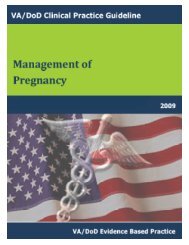DM Full Guideline (2010) - VA/DoD Clinical Practice Guidelines Home
DM Full Guideline (2010) - VA/DoD Clinical Practice Guidelines Home
DM Full Guideline (2010) - VA/DoD Clinical Practice Guidelines Home
Create successful ePaper yourself
Turn your PDF publications into a flip-book with our unique Google optimized e-Paper software.
Version 4.0<br />
EVIDENCE<br />
<strong>VA</strong>/<strong>DoD</strong> <strong>Clinical</strong> <strong>Practice</strong> <strong>Guideline</strong><br />
for the Management of Diabetes Mellitus<br />
Recommendation Sources LE QE SR<br />
1 Referral to a foot care specialist Working Group Consensus III Poor I<br />
for high-risk patients with minor<br />
foot wounds.<br />
2 Consideration of a footwear Bloomgarden, 2001 III Poor I<br />
prescription.<br />
LE-Level of Evidence; QE = Quality of Evidence; SR = Strength of Recommendation (see Appendix A).<br />
H. Perform and Document Patient Education for Preventive Foot Care and Footwear<br />
OBJECTIVE<br />
Empower the patient to perform proper foot care practices.<br />
RECOMMENDATIONS<br />
1. All patients and their families should receive self-management education for preventive foot care and<br />
selection of footwear. Instruction should include recommendations for daily foot inspection and preventive<br />
foot care, skin care, and use of emollients, nail care, and treatment for callus.<br />
DISCUSSION<br />
Begin with nonjudgmental assessment of the patient's current self-care practices including asking, "Do you do<br />
anything special to protect your feet?"<br />
Patient and family foot education should include the following components and considerations:<br />
• Keep it simple and appropriate for the patient's educational level.<br />
• Make it interactive, including demonstrations in washing, drying, and inspecting feet; nail cutting; and<br />
suitable footwear selection, including footwear for temperature extremes.<br />
• Provide opportunities for the patient to state the need for what are basics of daily skin and foot care and<br />
preventive measures.<br />
• Include practice time during the educational session to demonstrate and have the patient, in return,<br />
demonstrate safe toenail trimming.<br />
• Provide repetitive examples of and messages about how care of the feet can prevent complications. Include<br />
recommendations that distinguish minor foot problems from more serious problems that require early or<br />
immediate professional treatment, together with a name and telephone number for prompt assistance.<br />
• Make realistic recommendations (appropriate to the patient's physical and visual capabilities) while<br />
personalizing information and highlighting key points. This may include a referral to home healthcare.<br />
• Provide written guidelines in large print and/or graphics that the patient can hang in the bathroom as a<br />
reference and reprints of lay articles. Patients should be alerted that elevation in blood sugar might be a<br />
sign of an active or impending infection. Use of a night-light or turning on lights when getting up at night<br />
may prevent foot injuries. Patients should be made aware of potential dangers in the home.<br />
• For patients with high-risk feet, twice-daily inspection in good light is recommended, looking for any<br />
redness or drainage and running the hands over the foot to detect any swelling or increased local warmth.<br />
Patients with neuropathic fingers may need to enlist help or use a mirror to inspect their feet.<br />
• Before putting on shoes, inspect for torn linings, rough spots, and foreign objects (e.g., gravel, stones, glass,<br />
and children’s toys).<br />
• Alternating between pairs of shoes during the day is recommended. A minimum of two serviceable pairs<br />
of shoes, insoles, and orthoses are recommended.<br />
• Educators can utilize numerous publications on patient foot care instruction that are free of charge and have<br />
no copyright restrictions. The following publications are available through the U.S. Department of Health<br />
and Human Services, Centers for Disease Control and Prevention (CDC), and American Association of<br />
Diabetes Education (AADE):<br />
Module F – Foot Care Page 102
















